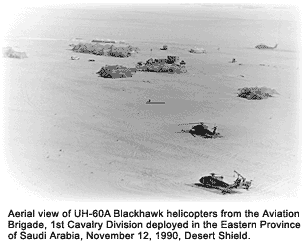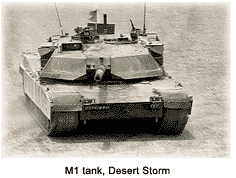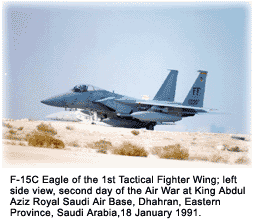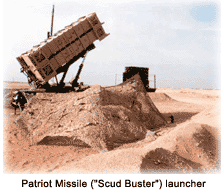Operation Desert Storm, popularly known as the first Gulf War, was the successful U.S.-Allied response to Iraq's attempt to overwhelm neighboring Kuwait. Kuwait's liberation in 1991 brought to the battlefield a new era of military technology. Nearly all battles were aerial and ground combat within Iraq, Kuwait, and outlying areas of Saudi Arabia. Iraq inflicted little damage on the American coalition; however, they fired missiles on Israeli citizens.
 History
History
At the request of the Kuwaitis, Kuwait had become a British Protectorate in 1889. British forces protected the area until 1961. Kuwait was a part of Iraq until 1923, when borders were drawn. On June 19, 1961, British protection ended and Kuwait joined the Arab League. Iraq objected strongly and claimed that Kuwait was part of their territory. Kuwait formed its own constitution on January 1963. Accordingly, the emir held the executive power, organized with a group of ministers. By January 23, a national assembly was elected. By October, 1963, Iraq gave up its claim on Kuwait. Iraqi dictator Saddam Hussein wanted to regain that lost land for Iraq, and so he invaded.
Leading up to war
On August 2, 1990, Iraqi forces invaded Kuwait. Iraqi dictator Saddam Hussein had been making threats against Kuwait for some time, but his actual invasion caught most of the world by surprise. The magnitude of the invasion also was a surprise. Those who had expected an attack, such as the commander of U.S. Central Command, Norman Schwarzkopf, expected a limited attack to seize Kuwaiti oil fields. Instead, within a number of hours, Iraqi forces had seized downtown Kuwait City and were headed south toward the Saudi Arabia border.
Word of the Iraqi attack reached Washington, D.C., as Iraqi forces assembled at the Saudi border. The Pentagon had plans in place to aid the Saudis, and U.S. forces went on standby for the Saudis' request. Secretary of Defense Dick Cheney and General Schwarzkopf met with King Fahd of Saudi Arabia to brief him on the plans, which he approved. Within minutes of the meeting, orders were issued, and thus began the largest buildup of American forces since the Vietnam War. Within a short period, members of the 82nd Airborne Division, as well as 300 combat aircraft, were headed for Saudi Arabia.
A deadline set for Saddam Hussein
By the end of September 1990, there were nearly 200,000 American personnel in Saudi Arabia — enough to repel any Iraqi attack.
The initial plan to drive Iraqi forces from Kuwait called for a direct offensive aimed at Kuwait City; but Schwarzkopf and other American commanders thought that the risk was too great against heavily armed, well-entrenched defenders. Instead, they called for additional troops to prepare for the largest military cleanup ever seen.
 President Bush (with Saudi approval) ordered an additional 140,000 soldiers, including the Third Armored Division with its Abrams M1A tanks. During that period, reinforcements from numerous other nations arrived, including British, French, Egyptian and even Syrian forces. On November 29, the UN Security Council passed a resolution authorizing the use of force if Iraq did not withdraw from Kuwait by January 15.
President Bush (with Saudi approval) ordered an additional 140,000 soldiers, including the Third Armored Division with its Abrams M1A tanks. During that period, reinforcements from numerous other nations arrived, including British, French, Egyptian and even Syrian forces. On November 29, the UN Security Council passed a resolution authorizing the use of force if Iraq did not withdraw from Kuwait by January 15.
Superior U.S. air power
On the morning of January 16, 1991, Allied forces began the first phase of Desert Storm, also known as Desert Shield. American forces first destroyed Iraqi border radar stations, then other key elements of the Iraqi anti-aircraft network; lastly, they began to bomb key targets in downtown Iraq, including the presidential palace, communication centers, and power stations. The Allied forces lost only two aircraft during the attacks. The assault continued day and night.
Those initial air attacks constituted the first time the American military witnessed how their new arsenal performed in combat conditions. With such ground systems as the M1A1 Abrams missile and the MIM-104 Patriot missile, the Iraq military had little opportunity to defend themselves. Also, such other groundbreaking technology as the Global Positioning System (GPS), helped to pinpoint hits by the Tomahawk missile and other weapons.
The damage done by U.S. air attacks was devastating to Saddam's vaunted Republican Guard. The following U.S. aircraft left "a big hurt" on the enemy during the war: AH-64 Apache helicopters, B-52 Stratofortress bombers, E-3 AWACS surveillance aircraft, F-117A Stealth fighters, E-8C JSTARS radar command posts, and the RPVs (drones).
 Overall, the coalition air campaign (consisting mostly of U.S. pilots) accumulated a total of 109,876 sorties over the 43-day air war — averaging 2,555 sorties per day. Of those, more than 27,000 sorties struck enemy Scuds, airfields, air defenses, electrical power, biological and chemical weapons caches, headquarters, intelligence assets, communications, the Iraqi army, and oil refineries.
Overall, the coalition air campaign (consisting mostly of U.S. pilots) accumulated a total of 109,876 sorties over the 43-day air war — averaging 2,555 sorties per day. Of those, more than 27,000 sorties struck enemy Scuds, airfields, air defenses, electrical power, biological and chemical weapons caches, headquarters, intelligence assets, communications, the Iraqi army, and oil refineries.
Scuds fired at Israel and the attack on Al Khafji
At 3 a.m on January 17, the Iraqis fired seven Scud missiles at Israel. Israelis were awaiting the Scuds with gas masks on, thanks to Saddam's previous threats to burn half of Israel with chemical weapons. As it turned out, the Scuds bore only conventional warheads, but their terror value was high. To avoid a wider war, U.S. officials pleaded with Israeli officials to not respond to the Scud attacks. The Israelis agreed because the Americans promised to target all Scud missile sites and knock them out.
On January 29, following two weeks of punishing coalition air assaults, the Iraqis mounted their one and only attack subsequent to the invasion at the Battle of Khafji. The Iraqi Fifth Mechanized Division attacked south, capturing the Saudi town of Al Khafji eight miles south of the Kuwaiti border. The Iraqis overran the first Saudi force that attempted a counterattack and, despite massive American air attacks, they held on to the town through the day and night. The next day was a different story, however, when Saudis recaptured the town, forcing the remaining Iraqis to flee to the Kuwaiti border.
 Operation Desert Sabre
Operation Desert Sabre
After a 38-day air campaign, Operation Desert Sabre, a massive ground attack, was launched by Americans and the coalition into both Iraq and Kuwait.
Day One ground attack. On February 24th at 4 a.m., Allied troops led by U.S. Marines crossed the border into Iraq. During the days before the attack, Iraqi troops had been subjected to merciless air attacks; every imaginable target was destroyed with accuracy.
The Allied offensive targeted three major offensive venues: the first aimed at Kuwait City, the second to the west aimed at the Iraqi flank, and the final one far to the west, beyond the major Iraqi lines that would totally outflank Iraqi lines. In the first day of the war the marines advanced halfway to Kuwait City and the western advances proceeded without difficulty — while capturing thousands of Iraqi deserters. The first day of ground fighting resulted in minimal American casualties.
Day Two ground attack. As Day Two approached, an Iraqi Scud missile destroyed the U.S. barracks in Dhahran, killing 28 U.S. soldiers. With morale nevertheless high, American troops advanced on all fronts. The marines approached Kuwait City, while the western flank began to cut off the Iraqi Army's retreat route. Coalition casualties for Day Two were, once again, light.
Day Three ground attack Day Three dawned on the largest tank battle in history. The American armored forces engaged the tank forces of the Iraqi Republican guard. Like shooting fish in a barrel, the American tanks destroyed the Iraqi heavy armor without losing a single tank.
On February 26th, Iraqi troops began to retreat from Kuwait while setting fire to an estimated 700 Kuwaiti oil wells. A long convoy of Iraqi troops, as well as Iraqi and Palestinian civilians, formed along the main Iraq-Kuwait highway. That convoy was bombed so relentlessly by the Allies that it came to be known as the "Highway of Death." One hundred hours after the ground campaign began, President Bush declared a cease-fire — declaring the liberation of Kuwait on February 27, 1991.
Postwar epilogue
On April 5th, 1991, President Bush announced that U.S. relief supply airdrops would be made to Kurdish refugees in Turkey and northern Iraq. After Iraq issued its acceptance of a cease-fire, Task Force Provide Comfort was formed and deployed to assist the Kurds.
The U.S. transport delivered some 72,000 pounds of supplies in the first six Operation Provide Comfort missions. By April 20, the construction of the first Provide Comfort tent city began near Zakhu, Iraq. By war's end, U.S. forces released 71,204 Iraqi prisoners to Saudi control.
U.S. casualties
Iraqi casualties
I led my country in confrontation by an aggression launched by 33 countries led by U.S., which waged war against Iraq, the Iraqis' confrontation of which is called by Arabs and Iraqis as the Battle of Battles (Um Al-Ma’arik), where Iraq stood fast against the invasion, maintaining its sovereignty and political system.
- Saddam Hussein's journal.